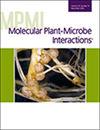求助PDF
{"title":"Technical Advances Drive the Molecular Understanding of Effectors from Wheat and Barley Powdery Mildew Fungi.","authors":"Merle Bilstein-Schloemer, Marion C Müller, Isabel M L Saur","doi":"10.1094/MPMI-12-24-0155-FI","DOIUrl":null,"url":null,"abstract":"<p><p>Pathogens manipulate host physiology through the secretion of virulence factors (effectors) to invade and proliferate on the host. The molecular functions of effectors inside plant hosts have been of interest in the field of molecular plant-microbe interactions. Obligate biotrophic pathogens, such as rusts and powdery mildews, cannot proliferate outside of plant hosts. In addition to the inhibition of the plant's immune components, these pathogens are under particular pressure to extract nutrients efficiently from the host. Understanding the molecular basis of infections mediated by obligate biotrophic pathogens is significant because of their impact in modern agriculture. In addition, powdery mildews serve as excellent models for obligate biotrophic cereal pathogens. Here, we summarize the current knowledge on the effectorome of the barley and wheat powdery mildews and putative molecular virulence functions of effectors. We emphasize the availability of comprehensive genomic, transcriptomic, and proteomic resources and discuss the methodological approaches used for identifying candidate effectors, assessing effector virulence traits, and identifying effector targets in the host. We highlight established and more recently employed methodologies, discuss limitations, and suggest additional strategies. We identify open questions and discuss how addressing them with currently available resources will enhance our understanding of <i>Blumeria</i> candidates for secretor effector proteins. [Formula: see text] Copyright © 2025 The Author(s). This is an open access article distributed under the CC BY-NC-ND 4.0 International license.</p>","PeriodicalId":19009,"journal":{"name":"Molecular Plant-microbe Interactions","volume":" ","pages":"213-225"},"PeriodicalIF":3.4000,"publicationDate":"2025-03-01","publicationTypes":"Journal Article","fieldsOfStudy":null,"isOpenAccess":false,"openAccessPdf":"","citationCount":"0","resultStr":null,"platform":"Semanticscholar","paperid":null,"PeriodicalName":"Molecular Plant-microbe Interactions","FirstCategoryId":"99","ListUrlMain":"https://doi.org/10.1094/MPMI-12-24-0155-FI","RegionNum":3,"RegionCategory":"生物学","ArticlePicture":[],"TitleCN":null,"AbstractTextCN":null,"PMCID":null,"EPubDate":"2025/4/23 0:00:00","PubModel":"Epub","JCR":"Q2","JCRName":"BIOCHEMISTRY & MOLECULAR BIOLOGY","Score":null,"Total":0}
引用次数: 0
引用
批量引用
Abstract
Pathogens manipulate host physiology through the secretion of virulence factors (effectors) to invade and proliferate on the host. The molecular functions of effectors inside plant hosts have been of interest in the field of molecular plant-microbe interactions. Obligate biotrophic pathogens, such as rusts and powdery mildews, cannot proliferate outside of plant hosts. In addition to the inhibition of the plant's immune components, these pathogens are under particular pressure to extract nutrients efficiently from the host. Understanding the molecular basis of infections mediated by obligate biotrophic pathogens is significant because of their impact in modern agriculture. In addition, powdery mildews serve as excellent models for obligate biotrophic cereal pathogens. Here, we summarize the current knowledge on the effectorome of the barley and wheat powdery mildews and putative molecular virulence functions of effectors. We emphasize the availability of comprehensive genomic, transcriptomic, and proteomic resources and discuss the methodological approaches used for identifying candidate effectors, assessing effector virulence traits, and identifying effector targets in the host. We highlight established and more recently employed methodologies, discuss limitations, and suggest additional strategies. We identify open questions and discuss how addressing them with currently available resources will enhance our understanding of Blumeria candidates for secretor effector proteins. [Formula: see text] Copyright © 2025 The Author(s). This is an open access article distributed under the CC BY-NC-ND 4.0 International license.
技术进步推动小麦和大麦白粉病真菌效应物的分子理解。
病原体通过分泌毒力因子(效应器)来操纵宿主的生理机能,从而侵入宿主并在宿主上增殖。植物寄主内效应体的分子功能一直是植物与微生物分子相互作用研究领域的热点。专性生物营养病原体,如锈病和白粉病,不能在植物宿主外增殖。除了抑制植物的免疫成分外,这些病原体还面临着从宿主有效提取营养物质的特殊压力。了解专性生物营养病原体介导的感染的分子基础对现代农业具有重要意义。此外,白粉病为专性生物营养谷物病原体提供了极好的模型。本文综述了大麦和小麦白粉病的效应组及其可能的分子毒力功能。我们强调全面的基因组学、转录组学和蛋白质组学资源的可用性,并讨论用于鉴定候选效应物、评估效应物毒力特征和鉴定宿主中效应物靶点的方法学方法。我们强调了已建立的和最近采用的方法,讨论了局限性并提出了额外的策略。我们确定悬而未决的问题,并讨论如何利用现有资源解决这些问题,以增强我们对蓝属植物csep的理解。
本文章由计算机程序翻译,如有差异,请以英文原文为准。

 求助内容:
求助内容: 应助结果提醒方式:
应助结果提醒方式:


